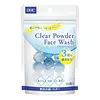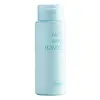What's inside
What's inside
 Key Ingredients
Key Ingredients

 Benefits
Benefits

 Concerns
Concerns

 Ingredients Side-by-side
Ingredients Side-by-side

Talc
AbrasiveZea Mays Starch
AbsorbentGlycylglycine
Microcrystalline Cellulose
AbsorbentZinc Lauroyl Aspartate
Dextrin
AbsorbentTea-Cocoyl Glutamate
CleansingTrehalose
HumectantSodium Taurine Cocoyl Methyltaurate
CleansingMyristyl Myristate
EmollientHydroxypropyl Methylcellulose
Emulsion StabilisingWater
Skin ConditioningSorbitol
HumectantAlgin
MaskingPhytosteryl/Octyldodecyl Lauroyl Glutamate
Skin ConditioningPolyquaternium-51
Skin ConditioningPapain
Skin ConditioningProtease
ExfoliatingLipase
Skin ConditioningZinc Phosphate
PEG-8 Phosphate
Skin ProtectingPhenoxyethanol
PreservativeTalc, Zea Mays Starch, Glycylglycine, Microcrystalline Cellulose, Zinc Lauroyl Aspartate, Dextrin, Tea-Cocoyl Glutamate, Trehalose, Sodium Taurine Cocoyl Methyltaurate, Myristyl Myristate, Hydroxypropyl Methylcellulose, Water, Sorbitol, Algin, Phytosteryl/Octyldodecyl Lauroyl Glutamate, Polyquaternium-51, Papain, Protease, Lipase, Zinc Phosphate, PEG-8 Phosphate, Phenoxyethanol
 Reviews
Reviews

Alternatives
Ingredients Explained
These ingredients are found in both products.
Ingredients higher up in an ingredient list are typically present in a larger amount.
These enzymes break down protein into smaller peptides and amino acids. They also encourage the formation of new protein.
Our skin uses peptides, amino acids, and protein for maintaining healthy skin cells.
Protease work by breaking peptide bonds in protein with hydrolysis. This is the process of breaking bonds using water.
An in-vitro study (not done on a living organism) found a blend of 3-protease decreases skin inflammation by mitigating the effects of other proteins.
One manufacturer that uses subtilisin, a protease from Bacillus subtilis, claims this ingredient is exfoliating, promotes cell regeneration, and is a good substitute for AHAs. Further research is needed to back up these claims.
Fun fact: The human body contains ~641 protease genes.
Learn more about ProteaseSorbitol is a sugar alcohol. It is a hydrating and moisturizing agent created from the reduction process of glucose.
Most sorbitol is usually made from potato starch. It is also found in fruits such as apples and pears.
As a humectant, Sorbitol helps draw water to the skin. This helps keep the skin hydrated. Sorbitol also helps create a thicker texture in products. You might find sorbitol in your toothpaste and other gels.
It is a non-irritating ingredient that is great for those with dry skin.
Sorbitol is a prebiotic. It helps promote the growth of healthy bacteria on your skin. The bacteria on your skin form a microbiome. This microbiome helps protect your skin from infection and harmful bacteria.
Learn more about SorbitolWater. It's the most common cosmetic ingredient of all. You'll usually see it at the top of ingredient lists, meaning that it makes up the largest part of the product.
So why is it so popular? Water most often acts as a solvent - this means that it helps dissolve other ingredients into the formulation.
You'll also recognize water as that liquid we all need to stay alive. If you see this, drink a glass of water. Stay hydrated!
Learn more about WaterZea Mays Starch is starch made from corn. You might know this as cornstarch . It is used to thicken a product. It can replace talc as an absorbent.
The pH of cornstarch is 5.92.
Cornstarch is a common food ingredient used to thicken soups or to make corn syrup.
Learn more about Zea Mays StarchThis ingredient is the simplest peptide derived from glycine. It has hair and skin conditioning properties.
According to a manufacturer, this ingredient is also used as a pH adjuster and is used as a starting template for creating more complex peptides.
It works best as a pH adjuster within a range of 7.5 - 8.9.
Learn more about Glycylglycine